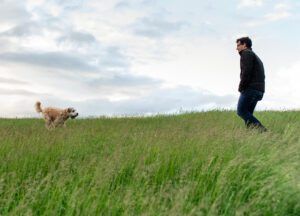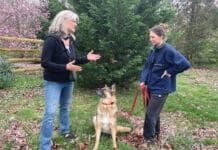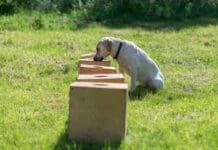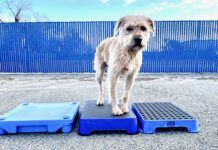Does your dog get to run off leash? I suspect it’s every dog’s fantasy to race full speed across an open meadow unrestrained by a leash, wind ruffling fur as they dart into the woods, hot on the heels of fresh bunny scent. Sadly, far too many dogs don’t get this opportunity because their humans haven’t trained them to be reliable off leash. If your dog is one of those who can’t go for a hike without an umbilical cord attaching her to you, it’s time to get to work!
On Leash Training
Before you even consider taking your dog off leash, she needs a solid foundation of good manners training on leash. This usually starts in a group class environment with a well-qualified force-free training professional, then needs to be generalized to the real world.
If you want your dog to be able to walk with you off leash, the following skills are prerequisites for your dog:
- Ability to walk politely on leash. (For help with teaching this skill to your dog, see “Polite Leash Walking,” WDJ September 2021.)
- A solid response to your recall cue (“Come!”). The ability to return quickly and reliably to you when called is especially critical when you work off leash. (See “Rocket Recall,” September 2015.)
- Targeting – where your dog approaches you and touches his nose or paw to your hand or some other part of your body – is a helpful close relative of the recall. It helps not only bring your dog back to you, but also asks for a particular body position. (See “On Target Training,” September 2021.)
- “Find It” is a cue that asks your dog to look for treats dropped at your feet. Like targeting, this can help grab your dog’s attention and bring him back to you.
Generalize Your Dog’s Training
Your next step is to generalize your dog’s training. Generalization means practicing your dog’s good manners behaviors in various public places (such as community parks, city streets, and shopping center parking lots), and dog-friendly commercial locations (pet supply stores, many hardware stores, etc.).
Specifically, practice distance work (teaching your dog to respond to your cues when he’s 6 feet and farther away from you) and blind work (where he is asked to respond to your cues when he’s behind you and you’re not making eye contact). For help with these more advanced skills, see “Beyond Basic Dog Training,” May 2021.
When your dog’s behaviors are solid around distractions in public, you’re ready to begin your off-leash training.
Start in a Large but Secure Space
Your dog’s training off leash begins in a private, securely fenced area where you can eventually let him off leash without worrying that he’ll disappear into the great beyond. If you don’t have a fenced yard, perhaps a friend or family member does. If not, check out Sniffspot – a company that contracts with property owners to make fenced spaces available to dog owners for an hourly fee (sniffspot.com).
You’ll need a long line – a sturdy nylon, polypropylene, or BioThane leash between 20 and 100 feet long that allows your dog to be a distance from you but still under your control. With your long line attached, let him move a short distance away from you and practice your Rocket Recalls, distance work, “Touch,” and/or “Find It.” Also in your fenced space, remove your long line and practice polite walking. Remember to use your happy voice and high-value reinforcers. Toys and play can be valuable reinforcers here, too; it doesn’t have to be just food treats!
This is an ideal opportunity to make use of the Premack Principle, which says you can use a more desirable behavior to reinforce a less desirable behavior (from the dog’s perspective). If your dog loves to sniff and dig, reward him for a lovely stretch of off-leash walking by giving him permission to go sniff the bushes or dig in the dirt.
When your dog is responding promptly, consistently, and reliably at close distances, gradually increase his range to the outer limits of your long line. If his responses start to falter as he moves farther away, go back to working at a closer distance. Remember to keep it fun!
When your dog can work reliably at the end of your long line you’re ready to let him go free – in your large but securely fenced space. Without changing your demeanor (keep it fun!), practice all his behavior cues.
Resist any temptation to get angry with him if he doesn’t respond. The use of an aversive tone of voice can “poison” your cues – giving him a negative association and making him less likely to respond well in the future. If he’s not responding as well as you hope, decrease the distance between you, increase the value of the reinforcers you have to offer him, and if necessary, put him back on the long line for more foundation work.
Off-Leash Training in the Real World
When all is going well in the fenced area, you’re ready for the next giant step – off to the real world! This can be tricky, since many municipalities don’t allow dogs off leash in public, and it’s important that you obey those leash laws.
Your first assignment is to find safe places where you can legally have your dog off leash. When you have found appropriate locations, go back to square one and start with your dog on a long line, working close to you. To set up your dog for success, identify times when there will be less activity and begin your training at those times.
Follow the same steps that you did in your fenced area, gradually increasing the distance between you and your dog while convincing him that it’s more fun to engage with you than to explore the world on hisown. When he’s responding to you well at times when there is little activity in that location, try times when there are more distractions, gradually working up to long line reliability at high-activity times.
Now the final step: Go back to the off-leash environment during a time of low activity, armed with high-value reinforcers. Warm up on the long line, then take a deep breath and remove the leash. Continue working with your dog as you have been – happy and upbeat.
Practice his favorite behaviors first, keeping him relatively close to you. Keep your off-leash sessions short, so you can end with success. Do a few minutes of training off leash, then put your dog back on leash and train some more. Have fun!
Watch for the arrival of any distractions that might be too much for your dog to handle. If you notice the impending arrival of something that might disrupt his training, calmly snap his leash back on until the distraction is gone.
As you enjoy success at low-activity times, gradually move your training to busier times.
Err on the Side of Caution

There’s a lot that can go wrong when you have your dog off leash. As well-trained as my dogs might be, I never try to walk them off leash along a busy street. If a car backfires or a skateboarder zooms past too close, even the best-trained dog could swerve sideways into the road and meet with tragedy.
So enjoy those off leash hikes in dog-friendly open spaces. Practice your good manners behaviors in community parks that welcome dogs. But if anything seems off – if there are one or more inappropriate dogs in the area, a human who seems uncomfortable with your well-behaved off-leash canine pal, or your dog just isn’t responding as well as she usually does – put the leash back on. You can always come back and play off leash another day, and another, and another.






